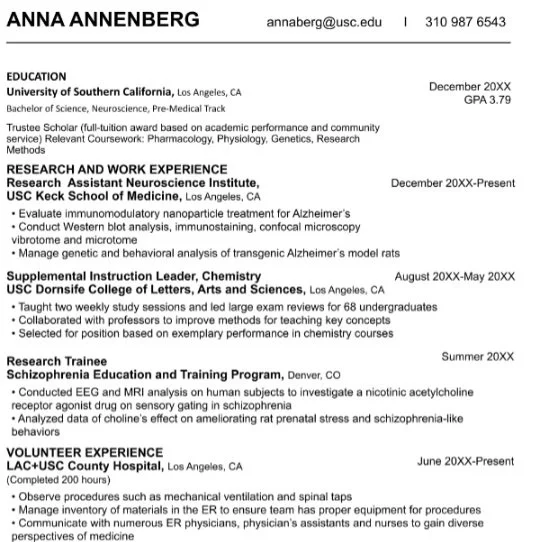USC Resume Tips and Tricks:
by Ela Rybak
No matter your major, creating a resume may seem daunting. There seem to be hundreds of different templates on Google, but thankfully, the USC Career Center offers concise guides on resume-making. These resources not only help you format your resume but also provide valuable tips on how to highlight your skills and experiences effectively.
Name and Contact Information: It's crucial to include your name in a large, bold font, along with your contact information—city, phone number, and email—at the top of your resume. Additionally, including your personalized LinkedIn URL next to your contact details makes it easier for recruiters to access your LinkedIn profile.
Education: List all of your college education in reverse chronological order, starting with the most recent institution or program first. This allows recruiters to see your current or most relevant academic experience at a glance. Be sure to include the name of the institution, the degree you are pursuing, and your major. You can also add your expected graduation date (e.g., May 2025) to provide clarity on your academic timeline.
Honors and Awards: Directly under education, is a prime place to place your honors and awards, especially if they correspond to a specific educational experience like Dean’s List or other scholar awards.
Experiences: Experiences should be listed in reverse chronological order, starting with the most recent. These can include extracurricular activities, such as clubs, as well as on-campus work experience, internships, apprenticeships, and other career-related experiences. To make your resume clearer and more organized, it's helpful to separate these experiences into distinct categories: professional experiences and volunteer or leadership experiences. For instance, school club involvement would go under the volunteer/leadership experience section, while an internship would be listed under the professional experiences section. This structure allows recruiters to easily differentiate between your career-related roles and other valuable experiences.
Research/Publications: Similar to the rest of your resume, list research and publications in reverse chronological order. For research, include organization involvement and any active roles you held within the research. In terms of publications, make sure to include the title, journal, and the final publish date. Also, clarify whether it is an article, chapter, or full book with page numbers, if possible.
Miscellaneous Tips:
Although not required, including a skills/interests section at the bottom of your resume, if there is room, helps to offer recruiters some unique facts about you that may help you stand out. A fun example of this could be “posting on my food Instagram account” or “playing the ukulele.”
Make sure to keep your resume to one page and 12 pt font of Times New Roman, Helvetica, or Verdana.
Include measurable achievements in your resume bullet points. For example, “Led the development of a new account that increased revenue by 15%.” This approach applies across industries, helping recruiters gain a clearer, more tangible sense of your accomplishments.
The details of your resume should align with your career aspirations. If you're aiming for a career in journalism, highlight research, publications, and presentations. On the other hand, business students should emphasize professional experience and relevant projects.
Overall, these are great tips to ensure that your resume appropriately represents you and your accomplishments in a professional and positive manner. However, it is important to note that your resume will always be a work in progress since you will always be taking part in new activities and experiences.

